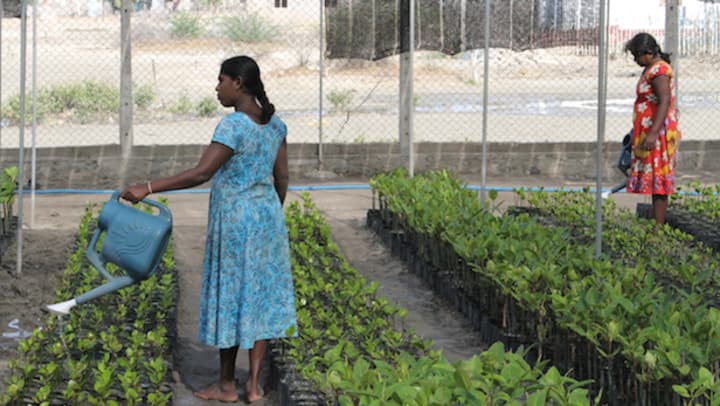Editor’s Note: This month, that is June 2020, FII’s #MoodOfTheMonth is Feminism And Environment, where we invite various articles about the diverse range of experiences which we often confront while interacting with our natural as well as social surroundings. If you’d like to share your article, email us at pragya@feminisminindia.com.
“Climate change is a man-made problem with a feminist solution,” states Mary Robinson, the first female president of Ireland and a vociferous advocate for gender equality and the environment.
Ecofeminism, a concept that was coined in 1974 by feminist Francoise d’Eaubonne ideologically links the environmental crisis with gender and highlights the importance of women playing a role in the conservation of the environment. It also highlights how both nature and women are oppressed at the hands of a patriarchal society that clutches on to the control of resources.

In India, however, the term ecofeminism has overtures of caste and class interlinkages playing a role within the ambit of gender. The degree of marginalization not only effectively increases the dependency on nature but also reduces decision-making opportunities for the marginalized section. Focus on the environment without considering gender disparities can cause further inequality. In Indian rural households, women are typically the primary providers of water, food and energy, and are often dependent on natural resources for their livelihoods. They are thus especially vulnerable to changes in the availability and access of these resources. For example, reduction in the water table due to the ongoing climate change would mean longer distances need to be covered by these women on foot to obtain water for their households. Rural women are thereby considered to be the worst affected section by climate change.
A UN Women report shows that women are more likely than men to use natural resources to increase overall family welfare and improve family food consumption thereby making them efficient at managing and utilizing limited resources. Thus, ideally they should play a pivotal role in the formation and execution of environmental policies (especially in areas and factors directly affecting them) but in actuality, they are rarely given the chance to do so. This deprioritization of women, both within their houses and at a policy level further pushes their issues into oblivion and poses a larger risk to their family welfare. Although they are the most adversely affected, ironically, this is the group that is more often than not ignored when it comes to strategising or implementing environmental policies.
In 2006, the National Environmental Policy was created which laid the framework for all policies that have since followed. This policy emphasized the need for human participation but the execution of this was often a slave to the patriarchal systems that were set in place. While it laid out several guidelines spanning over issues of pollution, forest conservation, industrialization, etc., it missed out on a key aspect of environmental conservation—the participation of women. The policy itself did not take into account the marginalized sections within communities who had limited access to resources and were therefore restricted in their ability to help in environment conservation.
A UN Women report shows that women are more likely than men to use natural resources to increase overall family welfare and improve family food consumption thereby making them efficient at managing and utilizing limited resources. Thus, ideally they should play a pivotal role in the formation and execution of environmental policies (especially in areas and factors directly affecting them) but in actuality, they are rarely given the chance to do so. This deprioritisation of women, both within their houses and at a policy level further pushes their issues into oblivion and poses a larger risk to their family welfare.
Sustainable energy resources were considered to be essential to future methods for tackling climate change, however the environmental policies on the topic excluded the perspectives of women who would essentially be the consumers of these new energy sources. According to a study by MK Thomas in 2010, over 30% of women in India do not have access to clean energy, often because of their financial dependency on their husbands. They were often forced to resort to the use of coal stoves, which not only resulted in more smoke but also caused several health issues, due to the lack of access to expensive cylinders. Therefore, empowering women to create and distribute renewable sources of energy would provide a double benefit of emancipating women and reducing the use of non-sustainable energy sources.
This problem of exclusion of women from the decision making process was also seen in the Indian implementation of the international Reducing Emissions from Deforestation and Forest Degradation program (REDD+) which aimed at reducing emissions from deforestation and forest degradation. This policy was seen to impact men and women differently with women being excluded from both national and local strategy-making processes. Studies show that inclusion of women in forest management and decision-making processes can lead to better conservation of forests.
Also read: Ecofeminism And COVID-19: Prejudices Of A Hindu Brahminical Society
As Dr. Vandana Shiva, a renowned ecofeminist, mentioned in an interview with Scott London, “My father had been a forester and I had grown up on those hills. I learned from the [peasant women] what forests mean for a rural woman in India in terms of firewood and fodder and medicinal plants and rich knowledge”. When women are made stakeholders in forest conservation, they feel a sense of ownership of the forests which motivates them to work towards conserving it.

Similarly, an article titled, “Challenging The “Man” In Mangroves: The Missing Role Of Women In Mangrove Conservation”, highlights how women are essential stakeholders in the conservation of mangroves. It talks about the power dynamics and relations that essentially dictate the control of mangrove conservation and how understanding these social systems can be the key to creating effective conservation strategies. For effective protection of these important ecological treasures, we need to first identify and acknowledge the varying roles and interactions of men and women with respect to these mangroves.
Most environmental policies in India have so far taken a single-pronged, bird eye approach to all environmental problems instead of considering a more localised strategy that includes women as invaluable stakeholders, not only in the implementation but also in the creation of policies. The formation of women’s Self Help Groups in various areas of South India that allow women to strategise developmental projects and take charge of the decision-making process and finances is an idea in the right direction but they need to be further encouraged and advanced.
Furthermore, a study carried out in MGR Thittu village in the vicinity of the Pichavaram mangroves in Tamil Nadu states, women are more likely to pay for the management and conservation of the mangroves as compared to their male counterparts in the village. Therefore, women can become active participants in the conservation and management of forests and mangroves. A gender-inclusive approach that takes into account the roles and importance of both men and women in conserving mangroves can lead to better results as opposed to when women are marginalized from the policy-making processes.
Also read: Environment, Conflict And Sustainability: The Fisherwomen Of Kashmir
Therefore, most environmental policies in India have so far taken a single-pronged, bird eye approach to all environmental problems instead of considering a more localised strategy that includes women as invaluable stakeholders, not only in the implementation but also in the creation of policies. The formation of women’s Self Help Groups in various areas of South India that allow women to strategise developmental projects and take charge of the decision-making process and finances is an idea in the right direction but they need to be further encouraged and advanced. As an article rightly points out, “Women are not passive victims of the environmental crisis”. They cannot and should not be excluded from policies and decisions . In the end, our very existence within this earth may depend on their empowerment.
Feature Picture Source: Feminism In India
About the author(s)
Vaishnavi Singh is an alumnus of The Young India Fellowship at Ashoka University. She is deeply interested in exploring the less understood aspects of something as vast and ever-changing as feminism. Vaishnavi is an opinionated introvert who loves travelling, watching movies and reading everything that she disagrees with.




